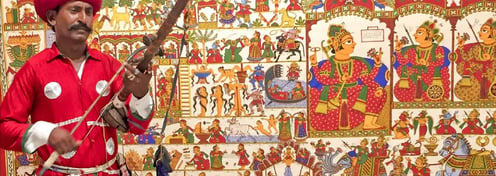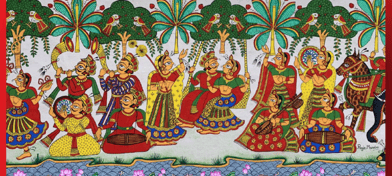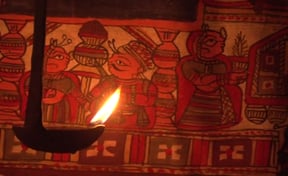Phad - A Musical Story
The Sacred Storytelling Art of Rajasthan
Phad painting is a traditional scroll painting that originated in Bhilwara and Shahpura regions of Rajasthan, more than 700 years ago. A blend of Rajput and Mughal styles of painting, it is a masterpiece of Indian art heritage.
Religious and divine in nature, it is painted on a long piece of cloth or canvas, known as phad. The word 'Phad' also means 'to unfold' in the native dialect. The narratives of the sacred folk deities of Rajasthan, mostly of Pabuji and Devnarayanji are depicted on the phads, and painted with natural vegetable dyes.
Phad paintings also cover other revered scriptural texts of India such as - Ramcharitmanas, Gita Govinda, Kumarasambhava, Bhagwad Gita and Sri Hanuman Chalisa.




Photo courtesy: Hinduism Today, IICD, Jaipur and medium.com


The Bhopas and Bhopis (the priest-singers and their wives) traditionally carried the painted phads (five feet wide and 15 to 30 feet long) along with them and used them as mobile temples, as they traveled from village to village, narrating stories through songs, poems and dance to the accompaniment of a musical instrument called Ravanahatha. It is believed that Phad art is a complete movie in itself where stories are narrated with visuals and music, not text.
With a full fledged script, musical arrangement, beautiful lyrics and expansive artwork that gets unfolded scene-by-scene to the delight of the audience, Phad simply enthrals. The story is performed for a duration of 30-45 minutes, sometimes even through entire nights, as Phads are unrolled only after sundown. When it gets too dark, the story continues with the Bhopi highlighting each scene by the radiant light of an oil lamp.
One of the most interesting characteristics of Phad art is the color scheme, that the artists meticulously adhere to. Vibrant raw colours (extracted from stones and pigments) fill up the entire canvas that is divided into sections - each section depicting a rich pictorial scene.
Characters are two dimensional and outlined with thick outlines. Colours are applied in a specific sequence - orange for the body of figures, yellow for ornaments and general clothing and designs, green for trees and vegetation, brown for architectural structures, red for royal clothing and flags, and blue for water. Finally, black is used to outline and complete the painting.
In modern times, Phad artists are also creating masterpieces in black and white for a beautiful monochromatic effect, combining text and images in collage formats, and creating artwork in smaller sizes as souvenirs for tourists and art lovers.
